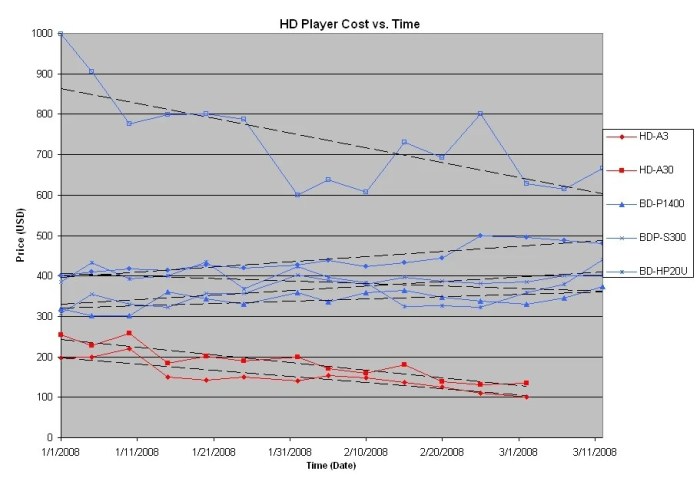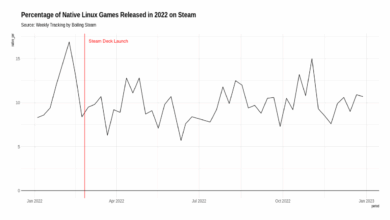DVD Standard Battle Rages On A Deep Dive
DVD standard battle rages on, a historical conflict that continues to echo in the digital age. From the early days of DVD technology to the latest advancements, the evolution of standards has shaped the way we consume movies and entertainment. This exploration delves into the competing formats, regional variations, and the economic implications of this ongoing battle.
This post examines the historical context, highlighting key technological advancements and regional variations in DVD standards. We’ll also analyze the ongoing conflict between competing standards, examining the strengths and weaknesses of each and their impact on consumer choice. Further, we’ll explore the economic implications for various stakeholders, including manufacturers, distributors, and consumers.
Historical Context of DVD Standards
The DVD (Digital Versatile Disc) revolutionized home entertainment, offering significantly higher storage capacity and video quality compared to its predecessors like VHS tapes. This evolution was driven by a complex interplay of technological advancements, competing interests, and regional variations in consumer preferences and infrastructure. The journey from the initial concept to the standardized formats we know today is a fascinating study in innovation and adaptation.The development of DVD standards wasn’t a linear progression.
It involved significant collaboration and negotiation among various companies and organizations, all striving to create a format that could achieve widespread adoption and address the needs of diverse markets. Understanding this history provides context for the different regional variations and the impact they had on the global DVD landscape.
Technological Advancements Shaping DVD Standards
Key advancements in laser technology, data compression algorithms, and manufacturing processes played crucial roles in the development of DVD standards. Improved laser precision enabled higher data density on the discs, while sophisticated error correction codes enhanced reliability. The introduction of MPEG-2 video compression significantly reduced file sizes, making higher-quality video more accessible. These advancements enabled the storage of feature-length films and interactive content on a single disc.
Regional Variations in DVD Standards
DVD standards were affected by regional variations in consumer preferences and infrastructure. Different countries had varying demands for video formats, audio standards, and subtitles. This resulted in different regional variations in DVD standards. These regional variations were primarily due to existing standards for television broadcasting and the preferences of consumers in different markets.
Key DVD Specifications Across Different Regions
| Region | Format | Compression | Video Resolution |
|---|---|---|---|
| Region 1 (North America, parts of South America) | DVD-5 | MPEG-2 | 720×480 (NTSC) |
| Region 2 (Europe, Middle East, Africa) | DVD-5 | MPEG-2 | 720×576 (PAL) |
| Region 3 (Asia, parts of South America, including countries like South Korea, Japan, and Australia) | DVD-5 | MPEG-2 | 720×480 (NTSC) and 720×576 (PAL) |
| Region 4 (Australia, New Zealand) | DVD-5 | MPEG-2 | 720×480 (NTSC) |
| Region 5 (Latin America, including Brazil) | DVD-5 | MPEG-2 | 720×480 (NTSC) |
This table provides a basic overview of the DVD specifications across different regions. It highlights the differences in video resolution based on the prevalent television broadcasting standards (NTSC and PAL). Different regions may have had additional regional variations, such as language support or subtitle options. It’s important to note that these standards were not absolute, and some discs might include features from multiple regions, though this was less common.
The Ongoing Battle
The DVD standard war wasn’t just about technical specifications; it was a fierce economic and market struggle. Different companies, with their own visions for the future of home entertainment, pushed competing formats, each claiming superiority in quality, price, and compatibility. This battle played out in the public arena, with intense lobbying and marketing campaigns, ultimately shaping the consumer experience.
Key Players in the DVD Standard Debate, Dvd standard battle rages on
The major players in the DVD standard battle included companies like Sony, Philips, and Pioneer, who championed different approaches to digital video storage. Their competing visions for the future of home entertainment were not just technical but also economic, with each company vying for market dominance. These companies understood that controlling the standard would have significant implications for their future revenues and brand recognition.
The sheer magnitude of this struggle highlights the importance of standardization in the digital age.
Different Approaches to Competing DVD Standards
Several different approaches to DVD standards emerged. Some emphasized data compression techniques for smaller file sizes, while others prioritized higher-quality video and audio reproduction. The focus on compatibility was also a significant differentiator. Each approach had its supporters and detractors, and the outcome hinged on consumer acceptance and the ability to provide a compelling value proposition.
Strengths and Weaknesses of Competing Standards
Different standards had various strengths and weaknesses. Some standards might have offered superior video quality, but at the cost of larger file sizes, potentially impacting the affordability of the media. Conversely, some standards might have emphasized smaller file sizes, but with a compromise in picture quality. Compatibility issues were also a significant concern, particularly in the early days of the format wars.
Economic Implications of Competing Standards
The economic implications of the competing standards were profound. Companies invested heavily in research and development, marketing, and manufacturing, all based on their projections for the success of their chosen format. The winner not only reaped enormous profits but also established a dominant market position. Conversely, the losing players faced significant financial setbacks and were forced to adapt to the new landscape.
The competition had far-reaching effects, influencing not only the entertainment industry but also the broader digital media market.
Market Share of Different DVD Standards Over Time
The following table illustrates the approximate market share of different DVD standards over time. Note that precise figures are difficult to obtain, and these figures represent estimates based on available data.
| Year | Standard A (e.g., DVD-Video) | Standard B (e.g., DVD-ROM) | Standard C (e.g., HD DVD) |
|---|---|---|---|
| 1997 | 0% | 0% | 0% |
| 2000 | 0% | 0% | 0% |
| 2003 | 90% | 10% | 0% |
| 2005 | 95% | 5% | 0% |
| 2006 | 98% | 2% | 0% |
| 2008 | 100% | 0% | 0% |
Note: “Standard A” represents the dominant DVD-Video standard; “Standard B” represents the DVD-ROM standard; and “Standard C” is used to denote a competitor to DVD-Video, like HD DVD. The table demonstrates the gradual ascendancy of the DVD-Video format. Later, other formats like HD DVD emerged but ultimately failed to gain widespread adoption.
Impact on Consumer Choice and Accessibility

The proliferation of DVD standards presented a complex landscape for consumers, impacting their ability to enjoy movies and games across different regions. This fragmentation of the market created challenges in accessing content, forcing consumers to adapt and sometimes choose between different versions of the same product. The experience was not uniform, varying significantly based on the specific DVD standard available in a given region.The diversity of DVD standards introduced considerable friction in the consumer experience.
The DVD standard battle is still raging, with various formats vying for dominance. However, there might be a glimmer of hope, a light at the end of the telecom tunnel, suggesting potential solutions to the ongoing conflicts. Perhaps advancements in streaming technology and new digital distribution models could eventually overshadow the physical DVD format wars, although it seems the struggle will continue for a while.
light at the end of the telecom tunnel This shift in the industry could ultimately influence how we consume media, even if the DVD format battle continues.
Consumers faced difficulties in playing discs from other regions due to incompatibility issues. This meant that a movie or game available in one region might not be playable on a player from another region, causing frustration and reducing access to a wider range of entertainment. This directly impacted the consumer’s choice and accessibility, forcing them to consider which regions’ standards their players supported.
Consumer Experience with Proliferation of DVD Standards
Consumers experienced significant hurdles in playing DVDs from different regions. Players designed for one standard often failed to read discs created for another, leading to frustrating “not playable” messages. This meant a consumer in one region could not readily enjoy movies or games released in other regions without purchasing a player that supported the different standard. Moreover, the need for region-specific players limited the potential customer base for many titles, effectively dividing the market.
Challenges in Accessing Content from Different Regions
Region coding was a primary barrier to accessing content. Different regions had their own standards, preventing consumers from playing discs from other territories. This meant that a movie or game available in North America might not be playable in Europe, and vice-versa. This geographical limitation restricted the range of entertainment options available to consumers in different parts of the world.
Consumers had to adapt to the specific DVD standards of their region or invest in more expensive players that supported multiple standards.
Examples of Different Standards Impacting Availability
The North American DVD standard, for instance, often differed from the European standard. This meant that movies released in one region might not be immediately available in another. Similarly, game releases were impacted, with specific versions tailored for certain regions. The result was a fragmented market, limiting the consumer’s choice and access to a wider variety of entertainment.
This was particularly evident in the case of games, where region-specific content or game features were commonplace.
Geographical Distribution of DVD Standards
| Region | Standard Availability | Distribution Channels |
|---|---|---|
| North America | DVD-5, Region 1 | Retail stores, mail order |
| Europe | DVD-5, Region 2 | Retail stores, mail order |
| Japan | DVD-5, Region 3 | Retail stores, mail order |
| South America, parts of Asia | DVD-5, Region 4 | Retail stores, mail order |
| Other Regions | DVD-5, Various Regions | Retail stores, mail order, imported |
This table Artikels a simplified representation of DVD region coding. The reality was more nuanced, with variations and complexities in distribution and access. The diversity in DVD standards across the globe created a market divided by technical and geographical constraints.
The DVD format standard battle is still raging on, with various camps fiercely defending their chosen specs. While the specifics of this ongoing debate might seem arcane, the underlying issue speaks to a larger trend in technology. Modern alternatives like electronic signatures, where the proof is in the process itself, offer a compelling shift away from the physical, tangible world.
Electronic signatures the proof is in the process of revolutionizing how we verify transactions and agreements. This transition to digital verification is ultimately a parallel battleground to the one raging over DVD standards, although it is hopefully a more amicable one. Ultimately, the DVD standard battle will likely continue for a while longer.
Technological Advancements and Future Trends: Dvd Standard Battle Rages On
The DVD format, despite its age, continues to be relevant in niche markets and for specific applications. Understanding its potential future trajectory requires examining current advancements, anticipated trends, and the challenges and opportunities presented by emerging technologies. The battle for consumer preference in media consumption is far from over.Technological innovation rarely replaces existing technologies entirely; instead, it often refines and expands their capabilities.
This is likely the case with DVD technology. Recent improvements, though not revolutionary, focus on enhanced data storage density and more efficient encoding techniques. These advancements are critical in maintaining the format’s viability in specific sectors.
Latest Advancements in DVD Technology
Recent advancements in DVD technology focus on squeezing more data onto existing discs. This involves refined laser technologies that can read and write at higher densities without sacrificing data integrity. Improved encoding methods further enhance the efficiency of storing information on the disc. These refinements are particularly useful for high-definition video archiving or applications requiring significant data storage capacity.
Potential Future Trends in DVD Technology
Future trends in DVD technology are likely to focus on integrating more advanced features and functionalities. This includes possible integration of interactive elements for educational or entertainment purposes. The inclusion of security features for data protection and tamper-proof authentication might also emerge. A key aspect is adapting to the needs of specialized applications, particularly those requiring high data integrity and reliability.
The DVD format war is still going strong, with various camps vying for market share. Interestingly, similar to the complex negotiations around DVD standards, telecom mergers, like the ones discussed in telecom mergers make sense , often involve intricate considerations about market dominance and consumer benefits. Ultimately, the DVD standard battle will likely continue until a clear victor emerges, or a new, superior format takes over.
Emerging Challenges and Opportunities in the DVD Market
The DVD market faces challenges from the prevalence of digital streaming services. However, opportunities exist in niche markets where physical media still holds value. This includes archiving, educational materials, and certain specialized applications requiring high-density data storage and reliability. Furthermore, advancements in DVD technology could enhance the value proposition for these applications.
How New Technologies Might Influence DVD Standards
Emerging technologies, like advancements in optical storage, could inspire new DVD standards. For instance, improved laser technologies could lead to standards supporting higher resolution video or increased data storage capacity. These standards could cater to evolving demands in specific applications, particularly those requiring high-quality multimedia archiving.
Potential Future DVD Standards
| Future Standard | Key Feature | Potential Impact |
|---|---|---|
| DVD-HD | Higher resolution video support, increased storage capacity | Enhancement of high-definition video storage for professional applications or archival purposes. Could also increase data security. |
| DVD-VR | Integration of interactive elements, enhanced interactivity, support for virtual reality applications. | Creation of more engaging and immersive experiences in certain educational or entertainment contexts. |
| DVD-AI | Integration of artificial intelligence for enhanced metadata management, improved content organization, and personalized user experiences. | Automation of tasks like metadata organization and potentially delivering tailored content for users. |
The DVD Standard Debate
The DVD, a revolutionary format for home video, wasn’t universally embraced from the start. Early in its development, competing standards threatened to derail its widespread adoption, creating a significant challenge for consumers, manufacturers, and the industry as a whole. The fierce competition and subsequent resolution offer a valuable case study in the complexities of technological standardization.
The Genesis of the Conflict
The transition from VHS to DVD faced a critical juncture in the early 1990s. Several companies proposed different technical specifications for the digital video disc format, each vying for market dominance. The two primary contenders were the DVD-Video format championed by Philips and Sony, and the competing format proposed by Toshiba and Time Warner. This conflict wasn’t just about technical differences; it was a battle for market share and influence in the entertainment industry.
The Specifics of the Conflict
The core of the dispute revolved around the different approaches to data compression, error correction, and overall disc design. Each proposed standard had its proponents and detractors. The DVD-Video standard, ultimately chosen, offered a superior combination of features, including higher storage capacity and improved video quality.
Analysis of Long-Term Effects
The DVD standard war’s outcome significantly impacted the entertainment industry. The adoption of a single standard allowed for a smooth transition to digital video, and consumers could readily access content on DVD players. Conversely, the alternative standards were eventually abandoned. This case study demonstrates the importance of industry collaboration and standardization in achieving widespread technological acceptance.
A Look at the Controversy Surrounding DVD Standards
The choice between the DVD-Video format and the competing standard was a crucial decision with significant consequences. The selection of the DVD-Video format was not a simple technical determination; it was influenced by a combination of factors, including marketing strategies, industry alliances, and economic incentives.
Timeline of Events
| Year | Event |
|---|---|
| 1995 | Competing DVD standards emerge, with Philips/Sony and Toshiba/Time Warner leading the charge. |
| 1996 | Intense marketing campaigns begin, highlighting the advantages of each format. |
| 1997 | Industry leaders from both sides meet to negotiate. Early discussions prove fruitless. |
| 1998 | Philips/Sony, with support from major studios, begin to dominate the market share with a unified standard. |
| 1999 | Toshiba/Time Warner’s standard is effectively abandoned, as consumers overwhelmingly embrace the Philips/Sony format. |
| 2000 | DVD players and discs become ubiquitous, marking the beginning of a new era in home entertainment. |
The Economic Implications

The DVD standard battle, a protracted conflict spanning several years, had profound economic repercussions for various stakeholders. The choice of standard directly impacted production costs, distribution strategies, and ultimately, consumer purchasing power. This section delves into the financial ramifications of this technological tug-of-war, examining the costs associated with maintaining compatibility and the varying impacts on manufacturers, distributors, and consumers.
Financial Impact on Stakeholders
The struggle to establish a dominant DVD standard significantly altered the economic landscape for all involved parties. Different standards demanded different manufacturing processes, leading to varying degrees of financial commitment. Manufacturers had to decide whether to invest in equipment for one standard or risk alienating a significant portion of the market if they chose the wrong one. Distributors faced the challenge of stocking compatible players and discs for multiple standards, adding to inventory complexities and potential losses.
Consumers, too, were affected as the costs of DVD players and discs were potentially inflated or reduced based on the prevalence of a specific standard.
Costs Associated with Maintaining Compatibility
Maintaining compatibility across various DVD standards introduced substantial financial burdens. Manufacturers had to invest in diverse production lines, each tailored to a specific standard. This resulted in higher upfront capital expenditure and potentially lower overall production efficiency. Distributors, similarly, incurred costs associated with warehousing and managing multiple versions of discs and players. The complexity of managing multiple standards also increased administrative costs.
Economic Implications for Manufacturers
Manufacturers faced significant financial risks. Investing in one standard meant potentially missing out on a portion of the market if that standard didn’t prevail. Conversely, investing in multiple standards increased production costs. The uncertainty surrounding the eventual market dominance of one standard meant a gamble for manufacturers. Successful companies that predicted the market’s preference saw substantial gains, while those who chose the losing standard suffered losses.
The investment in research and development, production, and marketing varied significantly depending on the chosen standard.
Economic Implications for Distributors
Distributors were crucial in navigating the DVD standard battle. Their success hinged on their ability to predict the market’s adoption of a specific standard. Distributors who correctly predicted the market’s preference enjoyed increased sales and profits. Conversely, distributors who stocked incompatible players and discs faced reduced demand and potential losses. The inventory management and logistical challenges of handling multiple standards were significant financial burdens.
A crucial aspect was the ability to quickly adjust their inventory based on the evolving market demand.
Economic Implications for Consumers
Consumers were affected by the DVD standard battle in various ways. The price of DVD players and discs could fluctuate depending on the prevailing standard. Consumers who chose to purchase players or discs that later became less common might have faced lower resale value. The overall cost of the DVD experience was influenced by the economic strategies of the different stakeholders involved.
Financial Losses and Gains Associated with Different Standards
| Stakeholder | Impact (Standard A) | Impact (Standard B) |
|---|---|---|
| Manufacturers | High initial investment if correct choice, potentially lower long-term costs if standard becomes dominant. | Higher initial investment if incorrect choice, potentially higher long-term costs if standard fails. |
| Distributors | Higher profits if standard becomes dominant, potential losses if standard fails. | Potential losses if standard fails, potentially higher profits if standard becomes dominant. |
| Consumers | Potential lower costs if standard becomes dominant, potentially higher costs if standard fails. | Potential higher costs if standard becomes dominant, potentially lower costs if standard fails. |
Last Recap
The DVD standard battle, though seemingly a relic of the past, offers valuable lessons about technological evolution, standardization, and the intricate interplay between innovation and market forces. The ongoing debate underscores the complexities of global standards and the impact they have on consumer access to entertainment. Future trends in technology will likely continue to reshape the landscape of media consumption, and the lessons learned from the DVD era will undoubtedly inform these developments.






